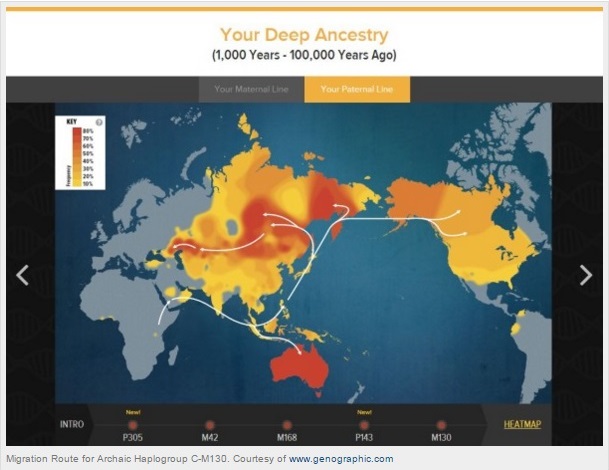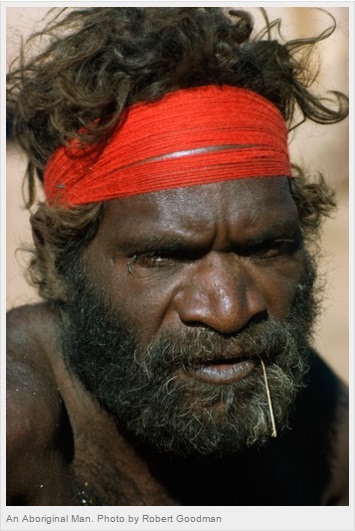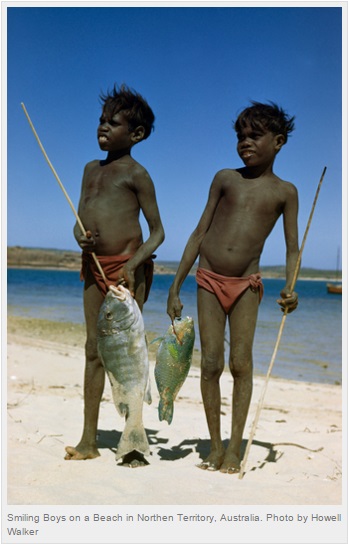


(※写真はナショ・ジオの記事より)



★日本列島に人類が定住したのは、支那大陸や朝鮮半島よりも相当に古い。(皇紀2676.1.6)
どのくらい古いかと言うと、アフリカ大陸を最初に出たヒト集団に遡る。
昨年12月に出された、人類学者・ロバート・ミッチェル博士らの研究論文を要約したナショナル・ジオグラフィックの記事「Genographic Researchers in Australia Uncover Unique Branches of the Human Family Tree 」によると、出アフリカを果たした最初のヒト(現生人類)の集団(Y染色体ハプログループC系統)は、アラビア半島南部→インド南部→マレー半島南部を通過して、当時無人のオーストラリア大陸に到達した。
父系の先祖を辿ることの出来るY染色体ハプログループC系統のうち、C-M130という最も古い系統に属している集団でオーストラリア大陸に住むアボリジニーである。
このC系統から分岐した一番古い集団がハプログループC1a1(C-M8)で、これは日本人からのみ見つかっている。これが、当時無人の日本列島にやってきた最初の日本人である。風貌はオーストラリアのアボリジニーのような褐色の肌で、漁労生活を送る様子はさながら神話に登場する海幸彦のようなヒトであったのかもしれない。
また、C系統から分岐したより新しい集団で、かつ最も繁栄した集団が、ハプログループC2系統である。このC2系統から分岐した集団の子孫は、モンゴル人や女真族など。
これらを古い順に辿っていくと、この地図のようになるのである。…従来も仮説として同様のことが言われていたのであるが、今回657人のアボリジニー男性から得られた結果に基づいて結論づけられたようである。
縄文系の最大集団のハプログループD1b(D-M64.1)系統が日本に到達する以前。もちろん、漢民族の系統であるO2(O-M122)の系統は誕生すらしていない時代、今の朝鮮半島も無人で、支那大陸もほぼ無人の時代のことである。
最古の出アフリカ集団は、オーストラリア大陸へ、また、東南アジアで分岐して日本列島を通過し、北東アジア・アメリカ大陸へと到達したようである。
Genographic Project scientists in Melbourne, Australia have just published their exciting new finds from years of work across the vast southern continent. Detailed in a new paper in the American Journal of Physical Anthropology, Dr. Robert Mitchell, student Nano Nagle, and their team of researchers worked with 657 Aboriginal Australian men mapping and dating the genetic diversity of the Australian Y chromosome.
Earlier work in Australia had suggested that Aborigines were descendants from the first migrants to leave Africa some 60 thousand years ago. The hypothesis suggests that when modern humans left Africa they remained in tropical regions, migrating north, then east and south around the Indian Ocean through India, Southeast Asia, eventually reaching Australia. Thus, understanding the origins of Australians is paramount to mapping the earliest human migrations.
The data from Nagle and Mitchell’s work supports an early entry into Australia through New Guinea some 50,000 years ago. However, their findings also show that indigenous New Guineans and Aboriginal Australians had been living isolated from one another for more than 30,000 years. Interestingly, before there was even an Australia and New Guinea, lower ocean levels exposed the seafloor between the two lands creating a supercontinent known as Sahul. Never having been connected to Asia, Sahul became the evolutionary birthplace to unique fauna such as marsupials, like kangaroos and koalas, which are found nowhere else in the world. These were the animals and plants the early migrants would have encountered upon first reaching the land down under. And these early migrants are the ancestors of modern Aboriginal Australians.
The Genographic study of Australian Aborigines included larger wider coverage of the continent than any previous work, and the percentage of rare haplogroups?genetically-related groups who share a common ancestor?was high and geographically distributed. A total of 292 individuals belonged to one of several uniquely Australian haplogroups: C-M347, K-M526, S-P308 or M-186 found throughout Queensland, South Australia and the Northern Territories. Five men were belonged to the ancient haplogroup C-M130, for example, with no close relatives outside the continent. Whereas haplogroup C-M347 was present in 19% of the Aboriginal men, yet it is branch unique to Australia.
Migration route for Archaic haplogroup C-M130. Photo courtesy of www.genographic.com.
Migration Route for Archaic Haplogroup C-M130. Courtesy of www.genographic.com In contrast, 56 percent of Aboriginal men had paternally-inherited Y chromosomes not native to Australia, and commonly associated with either Europe or Asia.
引用元記事
isogg tree